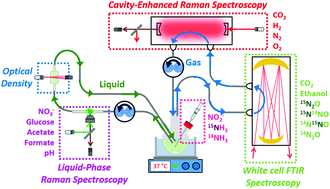Advanced spectroscopic analysis and 15N-isotopic labelling study of nitrate and nitrite reduction to ammonia and nitrous oxide by E. coli†
Abstract
Nitrate and nitrite reduction to ammonia and nitrous oxide by anaerobic E. coli batch cultures is investigated by advanced spectroscopic analytical techniques with 15N-isotopic labelling. Non-invasive, in situ analysis of the headspace is achieved using White cell FTIR and cavity-enhanced Raman (CERS) spectroscopies alongside liquid-phase Raman spectroscopy. For gas-phase analysis, White cell FTIR measures CO2, ethanol and N2O while CERS allows H2, N2 and O2 monitoring. The 6 m pathlength White cell affords trace gas detection of N2O with a noise equivalent detection limit of 60 nbar or 60 ppbv in 1 atm. Quantitative analysis is discussed for all four 14N/15N-isotopomers of N2O. Monobasic and dibasic phosphates, acetate, formate, glucose and NO3− concentrations are obtained by liquid-phase Raman spectroscopy, with a noise equivalent detection limit of 0.6 mM for NO3− at 300 s integration time. Concentrations of the phosphate anions are used to calculate the pH in situ using a modified Henderson–Hasselbalch equation. NO2− concentrations are determined by sampling for colorimetric analysis and NH4+ by basifying samples to release 14N/15N-isotopomers of NH3 for measurement in a second FTIR White cell. The reductions of 15NO3−, 15NO2−, and mixed 15NO3− and 14NO2− by anaerobic E. coli batch cultures are discussed. In a major pathway, NO3− is reduced to NH4+via NO2−, with the bulk of NO2− reduction occurring after NO3− depletion. Using isotopically labelled 15NO3−, 15NH4+ production is distinguished from background 14NH4+ in the growth medium. In a minor pathway, NO2− is reduced to N2O via the toxic radical NO. With excellent detection sensitivities, N2O serves as a monitor for trace NO2− reduction, even when cells are predominantly reducing NO3−. The analysis of N2O isotopomers reveals that for cultures supplemented with mixed 15NO3− and 14NO2− enzymatic activity to reduce 14NO2− occurs immediately, even before 15NO3− reduction begins. Optical density and pH measurements are discussed in the context of acetate, formate and CO2 production. H2 production is repressed by NO3−; but in experiments with NO2− supplementation only, CERS detects H2 produced by formate disproportionation after NO2− depletion.



 Please wait while we load your content...
Please wait while we load your content...